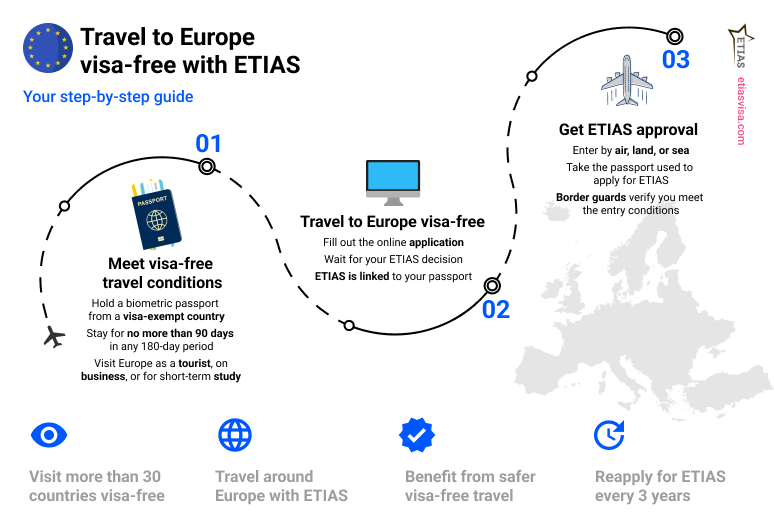
- Citizens of more than 50 non-EU countries can travel to Europe without a visa.
- You can visit most European countries visa-free from these non-EU nations.
More than a billion people from across the world can enjoy visa-free travel to Europe.
Passport holders from over 50 non-EU nations can enter Europe and stay for up to 90 days without applying for a visa.
To help you understand Europe’s visa-exemption policy, this page explains:
- Which nationalities can travel to Europe without a visa
- Which European countries you can visit visa-free
From 2026 , you need to register with the European Travel Information and Authorisation System (ETIAS) to travel without a visa.
TRAVELLERS FROM THESE COUNTRIES CAN VISIT EUROPE VISA-FREE
If your nationality appears on the list below, you can travel to European countries without Schengen visa. You must meet the conditions for visa-free entry.
- Albania
- Antigua and Barbuda
- Argentina
- Australia
- Bahamas
- Barbados
- Bosnia and Herzegovina
- Brazil
- Brunei
- Canada
- Chile
- Colombia
- Costa Rica
- Dominica
- El Salvador
- Georgia
- Grenada
- Guatemala
- Honduras
- Hong Kong
- Israel
- Japan
- Kosovo
- Kiribati
- Macao
- North Macedonia
- Malaysia
- Marshall Islands
- Mauritius
- Mexico
- Micronesia
- Moldova
- Montenegro
- New Zealand
- Nicaragua
- Palau
- Panama
- Paraguay
- Peru
- Saint Kitts and Nevis
- St Lucia
- St Vincent
- Samoa
- Serbia
- Seychelles
- Singapore
- Solomon Islands
- South Korea
- Taiwan
- Timor Leste
- Tonga
- Trinidad and Tobago
- Tuvalu
- Ukraine
- United Arab Emirates
- United Kingdom
- United States of America
- Uruguay
- Vanuatu
- Venezuela
*IMPORTANT: Special conditions apply to Ukrainian nationals at this time. The information on this page is not currently applicable to displaced Ukrainians in EU Member States.
WHICH EUROPEAN COUNTRIES CAN I VISIT WITHOUT A VISA?
If you hold a passport from one of the listed countries, you can visit European countries where Schengen visa policy applies visa-free.
As this does not include all European nations, it’s important to know which countries are included when planning your trip.

UNDERSTAND THE DIFFERENCE BETWEEN THE EU AND THE SCHENGEN AREA
To know which European countries you can visit without a visa, it is helpful to understand the difference between the European Union and the Schengen Area.
The EU is an economic and political union. Its primary objectives are to promote peace, stability, and prosperity in Europe.
The Schengen Area is a border-free travel region. People can travel within the Schengen Area without showing their passport or other identification.
Not all EU countries are in the Schengen Area, some are still in the process of joining. Ireland, as an opt-out, is the only EU country that is not legally obliged to join Schengen.
WHICH COUNTRIES ARE IN THE EU AND WHICH ARE IN THE SCHENGEN AREA?
| EU and Schengen Area | Only EU | Only Schengen |
|---|---|---|
| Austria | Cyprus | Iceland |
| Belgium | Ireland | Liechtenstein |
| Bulgaria | Norway | |
| Croatia | Switzerland | |
| Czech Republic | ||
| Denmark | ||
| Estonia | ||
| Finland | ||
| France | ||
| Germany | ||
| Greece | ||
| Hungary | ||
| Italy | ||
| Latvia | ||
| Lithuania | ||
| Luxembourg | ||
| Malta | ||
| Netherlands | ||
| Poland | ||
| Portugal | ||
| Romania | ||
| Slovakia | ||
| Slovenia | ||
| Spain | ||
| Sweden |
Ireland is aSchengen opt-out and is the only EU country not in the process of joining the Schengen Area.
SUMMARY OF VISA-FREE COUNTRIES IN EUROPE
If you are visa-exempt based on your nationality, you do not need a Schengen Visa for any of the European countries in the table above except Ireland.
Europe’s visa-exemption policy applies to Schengen members and countries in the process of joining the travel area (Cyprus).
You can also visit European microstates that have open borders with a Schengen country without a visa. Schengen visa policy applies to these nations de facto, even though they are not in the EU or the Schengen Area.
These microstates are:
- Andorra
- San Marino
- Monaco
- Vatican City
WHAT YOU NEED TO TRAVEL TO VISA-FREE EUROPEAN COUNTRIES
Your travel documents are checked at the external Schengen border when travelling to Europe. Here is what you need:
Biometric passport
- Issued by an eligible country.
- Valid for at least 3 months after you’ll exit the Schengen Area.
- Issued within the last 10 years.
ETIAS
- Starting in 2026 .
ETIAS IS ESSENTIAL TO VISA-FREE EUROPEAN COUNTRIES
From 2026 you need to register with the European Travel Information and Authorisation System to visit Europe without a visa.
ETIAS is a visa waiver, similar to the United States ESTA, for visa-exempt travellers. If you are from a visa-exempt non-EU nation and you are travelling to a country where Schengen visa policy applies, you do not need a visa for Europe but you do need ETIAS.
The application process is online. You need to fill out an electronic form with basic personal and passport details. The approved travel authorisation is linked to your passport and verified when you cross an external Schengen border.
You do not need to apply for ETIAS every time you travel to Europe without a visa. It is valid for 3 years (unless your passport expires sooner) and multiple trips to the ETIAS countries.
RULES FOR TRAVELLING TO EUROPE WITHOUT A VISA
There are some limits on travelling to Europe without a visa. You can go to Europe without a visa for:
- Up to 90 days per 180-day period
- Tourism, business, and other short-stay activities
To work in Europe or stay longer than 3 months, you must apply for a visa. You need to get a national visa for your European destination.
QUESTIONS ABOUT VISA-FREE TRAVEL TO EUROPE
CAN I TRAVEL ACROSS EUROPE WITHOUT A VISA?
You can travel across Europe without a visa, provided you are from a visa-exempt nation. Your passport and, from 2026 your ETIAS, are checked at the external Schengen border.
Once you have crossed the border, you can travel freely around all countries in the travel zone. Your stay must not exceed 90 days in any 180-day period.
Make sure all the countries you wish to visit are included in the visa-exemption policy—visa-free entry does not apply to all countries in Europe.
WHAT DO I NEED TO TRAVEL TO IRELAND?
Ireland is an EU country but it is not in the Schengen Area. Ireland sets its own visa policy which, although similar to that of the Schengen Area, is not exactly the same.
Some nationalities that enjoy visa-free entry to Schengen countries need a visa for Ireland. In addition, Ireland’s visa-exemption programme includes several additional countries.
If you plan to visit Ireland, you must check the visa requirements for your nationality.
HOW LONG CAN I SPEND IN EUROPE WITHOUT A VISA?
You can go to Europe without a visa for up to 90 days per 180-day period. These can be consecutive days or divided amongst different trips.
For longer stays in Europe, you must apply for the relevant visa.
CAN I TRAVEL TO THE UK WITHOUT A VISA?
Whether or not you need a visa for the UK depends on your nationality and your reason for travelling.
Citizens of several countries can visit the United Kingdom without a visa for up to 6 months for reasons including tourism, visiting family or friends, or short-term study.
You must get a visa for the UK to stay for more than 6 months or for work or long-term study. Make sure you check the latest entry requirements for your nationality.
WHICH EUROPEAN COUNTRIES DO I NEED A VISA FOR?
If you plan to visit any of the countries listed below, you must check the visa requirements.
- Albania
- Armenia
- Azerbaijan
- Belarus
- Bosnia and Herzegovina
- Georgia
- Ireland
- Kosovo
- North Macedonia
- Moldova
- Montenegro
- Russia
- Serbia
- Turkey
- Ukraine
- United Kingdom
These countries are not part of the EU or the Schengen Area. Schengen visa does not apply which means you may need a visa to travel.

